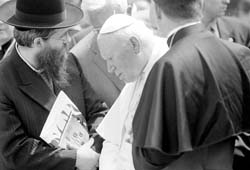WASTE NO TIME! HAVE NO FEAR!

An event took place in Ukraine that only recently would have seemed totally impossible, as Kyiv streets saw a very unusual cortege led by the popemobile with a regal old man in it, greeting onlookers. Pope John Paul II was beginning his visit. His first speech on Ukrainian soil (delivered in Ukrainian) had these words, “I have come to you, esteemed citizens of Ukraine, as a friend of your noble people. I am here as your brother in faith, so I can embrace all the Christians who have preserved their loyalty to Christ under the hardest of ordeals... I greet all citizens of Ukraine, cultural and confessional distinctions notwithstanding, because all of you have one history, as well as the disillusionment and hope that you have all experienced... I am aggrieved to state that our history, when the Face of Jesus, with His boundless love for man, was clouded. Bowing our heads before Our Lord, we should confess our sins. Just as we beg His forgiveness for our transgressions in the far and recent past, so shall we have to forgive all the injustices that have come our way. It is my most cherished desire to prevent past mistakes from being repeated, ever again. My our memories of past mistakes never become an obstacle to mutual understanding, which is the source of brotherhood and cooperation.”
We spent several years debating the pontifical visit. Those supporting and opposing the idea have, nevertheless, agreed that John Paul II’s visit to Ukraine would be an historically unprecedented event, something very much out of the ordinary, with very serious consequences. There have been countless arguments presented for and against the visit, finally getting so many had become convinced the project would remain on paper — as has been the case with many worthy initiatives lost in our habitual sea of verbiage.
Those opposing the visit claimed that the Vicar of Christ would inflict “irreparable damage on Ukrainian Orthodoxy” (in only five days) and that he would “assert Catholicism in Ukraine, unite the Orthodox with the Uniates, desecrate our national tabernacles, sell Ukraine out to the West.” Ordered by archpriests of the Ukrainian Orthodox Church (Moscow Patriarchate), round-the-clock prayers started in front of the holy images and those of the Mother of God, the way it had been done at a facing a major calamity. As the Pontiff set foot on Ukrainian soil, the Moscow patriarch severely admonished the faithful to be vigilant, threatening the Vatican that there could be irreversible consequences (In fact, we should thank the Russian Orthodox hierarchs’ aggressive resistance for the pontifical visit gaining such unprecedented publicity). By acting in such manner, the Moscow-affiliated shepherds placed their flock in an extremely embarrassing situation, opposing the faithful to both the regime and most of society. And those remaining loyal to the Ukrainian Orthodox Church (Kyiv Patriarchate) were in for a bitter fiasco. Was the pontifical visit aimed at exacerbating interfaith differences in Ukraine?
Actually, those campaigning for the visit also sounded very decisive, predicting the “reconciliation of split Orthodoxy,” “general improvement of the interfaith situation,” “a new level of peace and accord in society,” “radical changes [for the better] in Ukraine’s international image,” “better prospects for [international] loans,” and such. In a word, they expected from the visit something we could and should have accomplished ourselves. Of course, such things simply do not happen.
One of the most important events of the pontifical visit was John Paul II’s meeting with members of the All-Ukraine Association of Churches and Religious Organizations, where he reminded those present that man’s genuine freedom is impossible without freedom of conscience. The Pontiff showed the ecumenical approach in action, exchanging ideas with people representing different religions and confessions — Orthodox, Protestants, Muslims, and Jews. Nor did the Pope ignore what are generally regarded as the uncanonical Orthodox churches of Ukraine. He did not hesitate to accept greetings from Filaret, head of UOC (KP), a clergyman anathematized by the Moscow Patriarchate. And he cordially received the Rt. Rev. Mefody of the Ukrainian Autocephalous Orthodox Church (still unrecognized by the world Orthodox community), doing precisely what the Moscow hierarchs had strongly warned the Pontiff against.
Everything points to the pontifical visit giving a powerful impetus to Ukrainian society, both historically and at level of the current public mentality. Another bogey — engineered to keep Ukraine away from the highways of modern civilization — will slowly but surely sink into oblivion. Numerous polls testify that a mere 5% of the Ukrainians were actually opposed to the pontifical visit — compared to Ukraine’s statistically 51% of religious believers. In other words, just a handful of the faithful — those taking orders from the UOC Moscow Patriarchate. The fact remains that we, by letting John Paul II visit our land, have proclaimed our open and tolerant religious stand, as well as our rejection of that medieval reticent provincialism. This is something we should all feel happy about, for it inspires hope and joyous expectations.
Several years ago, John Paul II (born Karol Wojtyla), humanist, philosopher, and teacher, told his Polish compatriots, “Freedom is nothing we can simply have, it must be constantly reasserted... My people is still undergoing a trial of humanness, national dignity, and European conformance. Waste no time! Have no fear!” Now he has addressed the same message to the Ukrainian nation.






